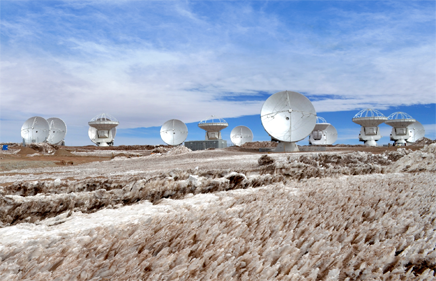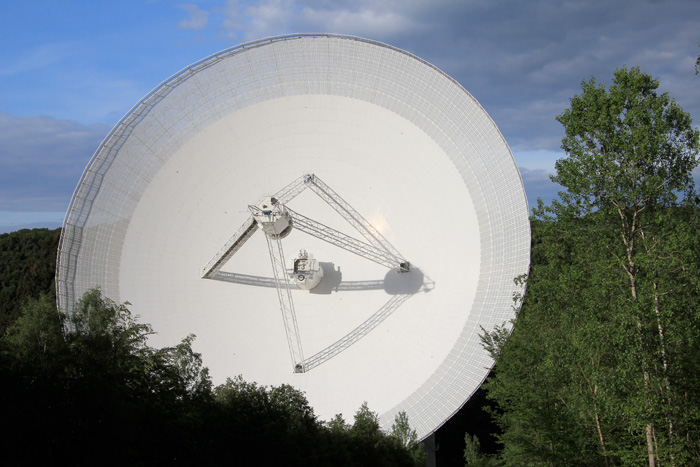
Figure 1: Antennas of ALMA, the "Atacama Large Millimetre Array", at 5100 m altitude at Chajnantor (Atacama Desert, Chile).
27 Partner organizations with world-class instruments work together in observations, research & development
5 January 2012 - The European radio astronomy collaboration, RadioNet, is recognized as the European entity to give access to and to exploit a number of excellent facilities in this field of astronomical research. The application for funding its latest version - RadioNet3 - has been successful, and a total of 9.5 million Euro have been granted by the European Commission for the years 2012 to 2015. This not only continues the two preceding European projects, but also takes a leap forward including ALMA, the radio interferometer for submillimetre wavelengths in Chile as well as a number of pathfinder programs for the Square Kilometre Array, SKA.
The Max Planck Institute for Radio Astronomy (MPIfR) in Bonn is leading 27 partners. The consortium includes 24 key players in radio astronomy in Europe and three additional ones from South Korea, Australia and South Africa.

Figure 2: Artist's impression of SKA dishes. Credit: ESO/ALMA (www.alma-telescope.org); SPDO/TDP/DRAO/Swinburne Astronomy Productions.
The main goal of RadioNet3 is to maximise use of the complete range of 18 state-of-the-art European radio-astronomical facilities, such as the 100m radio telescope of MPIfR (Fig 2). They offer access over an unprecedented range of wavelengths, from the largely uncharted decametric astronomy explored using the Low-Frequency Array (LOFAR), to the submillimetre range offered by telescopes in Hawaii (JCMT), France/Spain (IRAM) and Chile (APEX, ALMA). Among the facilities to which RadioNet provides access are recognized European SKA pathfinder efforts, such as the European VLBI Network (EVN), with its new real-time capabilities, e-MERLIN, the multibeam upgrade of Westerbork and the aforementioned LOFAR. In addition, RadioNet3 will play a role in stimulating European users to take advantage of two precursor projects for the SKA: ASKAP and MeerKAT (under construction in Australia and South Africa, respectively).
The networking activities of RadioNet3 will transform the way science is conducted in Europe; they will provide a natural forum for developing European collaborations, for the sharing of ideas and results and for mobilizing the researchers themselves. This is important with the emergence of new research opportunities through SKA and its pathfinder telescopes.
The RadioNet3 research programme will support targeted Research & Development to the facilities, developing new techniques that allow radio astronomers to make more efficient use of telescopes. The developments will provide an essential step in making sure that the European radio astronomical facilities offer competitive opportunities in the world.
"Our aim is to establish a long-term strategy for structuring radio astronomy in Europe", says Prof. Anton Zensus, Director at MPIfR and coordinator of the RadioNet3 project. "We will make sure the results are available to the outside world and the next generation of scientists and engineers are prepared for the advent of the new generation radio telescopes."

Figure 2: The 100m radio telescope of MPIfR near Effelsberg, Germany. Image: MPIfR/N. Junkes
Further Information:
- RadioNet (Advanced Radio Astronomy in Europe)
- Max Planck Institute for Radio Astronomy (MPIfR)
- Atacama Large Millimeter/submillimeter Array (ALMA)
- Square Kilometre Array (SKA)
Contact:
Prof. Dr. Anton Zensus
Director, Coordinator of RadioNet3 project
Max-Planck-Institut fuer Radioastronomie, Bonn
Phone: +49-228-525-378
E-mail: azensus@mpifr.de
Dr. Izabela Rottmann
RadioNet3 Project Management
Max-Planck-Institut fuer Radioastronomie, Bonn
Phone: +49-228-525-424
E-mail: irottmann@mpifr.de
Dr. Norbert Junkes
Public Outreach
Max-Planck-Institut fuer Radioastronomie, Bonn
Phone: +49-228-525-399
E-mail: njunkes@mpifr.de
